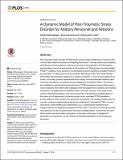A Dynamic Model of Post-Traumatic Stress Disorder for Military Personnel and Veterans
Author(s)
Ghaffarzadegan, Navid; Ebrahimvandi, Alireza; Jalali, Mohammad
DownloadGhaffarzaden, Edrahimvandi, Jalali,2016 A Dynamic Model of PostTraumatic Stress Disorder.pdf (1.403Mb)
Metadata
Show full item recordAbstract
Post-traumatic stress disorder (PTSD) stands out as a major mental illness; however, little is known about effective policies for mitigating the problem. The importance and complexity of PTSD raise critical questions: What are the trends in the population of PTSD patients among military personnel and veterans in the postwar era? What policies can help mitigate PTSD? To address these questions, we developed a system dynamics simulation model of the population of military personnel and veterans affected by PTSD. The model includes both military personnel and veterans in a “system of systems.” This is a novel aspect of our model, since many policies implemented at the military level will potentially influence (and may have side effects on) veterans and the Department of Veterans Affairs. The model is first validated by replicating the historical data on PTSD prevalence among military personnel and veterans from 2000 to 2014 (datasets from the Department of Defense, the Institute of Medicine, the Department of Veterans Affairs, and other sources). The model is then used for health policy analysis. Our results show that, in an optimistic scenario based on the status quo of deployment to intense/combat zones, estimated PTSD prevalence among veterans will be at least 10% during the next decade. The model postulates that during wars, resiliency-related policies are the most effective for decreasing PTSD. In a postwar period, current health policy interventions (e.g., screening and treatment) have marginal effects on mitigating the problem of PTSD, that is, the current screening and treatment policies must be revolutionized to have any noticeable effect. Furthermore, the simulation results show that it takes a long time, on the order of 40 years, to mitigate the psychiatric consequences of a war. Policy and financial implications of the findings are discussed.
Date issued
2016-10-07Publisher
PLOS One
Citation
http://journals.plos.org/plosone/article?id=10.1371/journal.pone.0161405